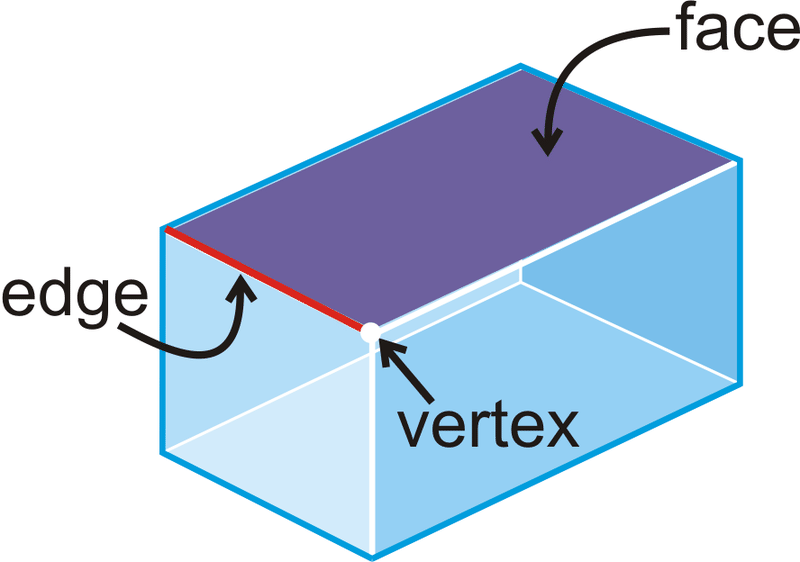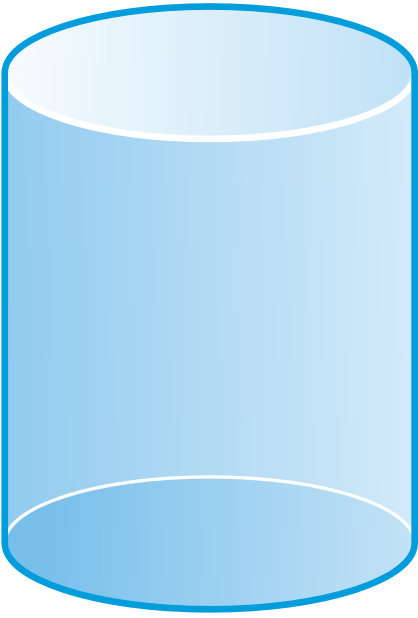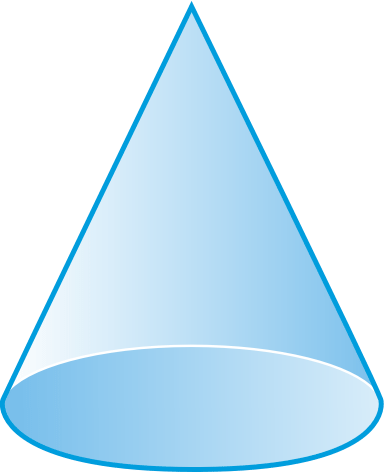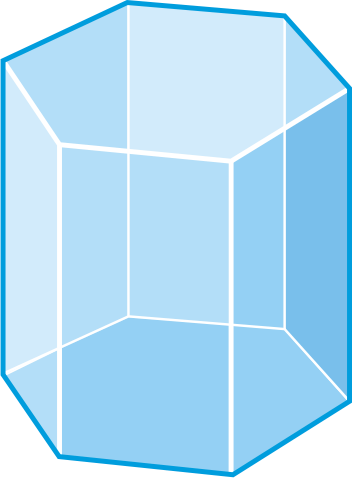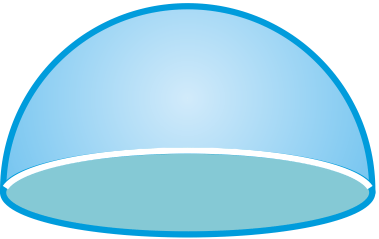聚面线
章节大纲
-
Polyhedrons
::聚面线A polyhedron is a 3-dimensional figure that is formed by polygons that enclose a region in space . Each polygon in a polyhedron is a face . The line segment where two faces intersect is an edge . The point of intersection of two edges is a vertex .
::多面形是一个三维图,由在空间中嵌入一个区域的多边形组成。多面形中每个多边形都是面孔。两面交叉的线条段是边缘。两个边缘的交叉点是一个顶点。Examples of include a cube, prism , or pyramid . Cones, spheres, and cylinders are not polyhedrons because they have surfaces that are not polygons. The following are more examples of polyhedrons:
::包括立方体、棱晶体或金字塔。 锥体、 球体和圆柱体不是聚希德龙, 因为它们的表面不是多边形。 下面是多希德龙的更多例子:The number of faces ( ), vertices ( ) and edges ( ) are related in the same way for any polyhedron. Their relationship was discovered by the Swiss mathematician Leonhard Euler, and is called Euler’s Theorem .
::脸部(F)、脊椎(V)和边缘(E)的数量与任何多面形都以同样的方式相关。 它们的关系是由瑞士数学家Leonhard Euler发现的,并被称为Euler的理论。Euler’s Theorem: .
::Euler的理论:F+V=E+2。
::面孔+Vertices=Edges+25+6=9+2A regular polyhedron is a polyhedron where all the faces are congruent regular polygons. There are only five regular polyhedra, called the Platonic solids.
::普通聚希德龙是一种聚希德龙,所有面孔都是相近的正多边形。只有五个普通的聚希德龙,叫做等离子固体。-
Regular Tetrahedron:
A 4-faced polyhedron and all the faces are
.
::常规德黑兰面板:四面形的多元面板和所有面孔都是。 -
Cube:
A 6-faced polyhedron and all the faces are squares.
::立方体:一个六面体的多面体 和所有面孔都是方形的。 -
Regular Octahedron:
An 8-faced polyhedron and all the faces are equilateral triangles.
::普通八面形: 8 面多面形和所有面孔都是等边三角形。 -
Regular Dodecahedron:
A 12-faced polyhedron and all the faces are regular pentagons.
::普通十二面体: 12面的多元面体和所有面孔都是普通的五边形。 -
Regular Icosahedron:
A 20-faced polyhedron and all the faces are equilateral triangles.
::普通的 Icosahedron : 20 面的多元面和所有面孔都是等边三角形。
What if you were given a solid three-dimensional figure, like a carton of ice cream? How could you determine how the faces, vertices, and edges of that figure are related?
::如果给了你一个坚固的三维图,比如一箱冰淇淋呢?你如何确定该图的面孔、脊椎和边缘是如何联系在一起的?Examples
::实例Example 1
::例1Determine if the following solids are polyhedrons. If the solid is a polyhedron, name it and find the number of faces, edges and vertices its has.
::确定以下的固体是否为聚希德龙。 如果固态是聚希德龙, 请给它命名, 并找到它拥有的面、 边缘和顶点的数量 。The base is a triangle and all the sides are triangles, so this is a triangular pyramid, which is also known as a tetrahedron . There are 4 faces, 6 edges and 4 vertices.
::基座是一个三角形,所有侧面都是三角形, 所以这是一个三角形的金字塔, 也称为阿提拉面。 面部有4张, 边缘有6张, 脊椎有4张。This solid is also a polyhedron. The bases are both pentagons, so it is a pentagonal prism. There are 7 faces, 15 edges, and 10 vertices.
::这颗固体也是多面体。 基底是五边形, 所以是五边棱镜。 共有7张面, 15个边缘, 10个脊椎 。The bases are circles. Circles are not polygons, so it is not a polyhedron.
::底部是圆圈,圆圈不是多边形,所以不是圆形。Example 2
::例2In a six-faced polyhedron, there are 10 edges. How many vertices does the polyhedron have?
::在六面圆面的圆形中,有10个边缘。多面圆形有多少个顶峰?Solve for in Euler’s Theorem.
::在尤勒的理论中解决V问题。
::F+V=E+26+V=10+2V=6Therefore, there are 6 vertices.
::因此,有6个顶峰。Example 3
::例3Markus counts the edges, faces, and vertices of a polyhedron. He comes up with 10 vertices, 5 faces, and 12 edges. Did he make a mistake?
::马库斯计算了多面形的边缘、面部和顶部。他提出了10个顶部、5个脸部和12个边缘。他犯了错吗?Plug all three numbers into Euler’s Theorem.
::将所有三个数字都插进欧勒的理论中。
::F+V=E+25+10=12+21514Because the two sides are not equal, Markus made a mistake.
::因为双方不平等 马库斯犯了一个错误Example 4
::例4Find the number of faces, vertices, and edges in an octagonal prism.
::在八角棱镜中查找面、顶和边缘的数量。There are 10 faces and 16 vertices. Use Euler’s Theorem, to solve for .
::有10张脸和16个顶点。 使用欧勒的理论为E解答。
::F+V=E+210+16=E+224=ETherefore, there are 24 edges.
::因此,有24个边缘。Example 5
::例5A truncated icosahedron is a polyhedron with 12 regular pentagonal faces, 20 regular hexagonal faces, and 90 edges. This icosahedron closely resembles a soccer ball. How many vertices does it have? Explain your reasoning.
::短短的象形面板是一个有12个普通的五角形面孔、20个普通的六角形脸孔和90个边缘的圆形面板。 这个象形面板很像一个足球球。 它有多少个脊椎? 请解释你的推理。We can use Euler's Theorem to solve for the number of vertices.
::我们可以用欧勒的理论解答脊椎的数量
::F+V=E+232+V=90+2V=60Therefore, it has 60 vertices.
::因此,它有60个顶点。Review
::回顾Complete the table using Euler’s Theorem.
::使用 Euler 的定理完成表格 。Name Faces Edges Vertices 1. Rectangular Prism 6 12 2. Octagonal Pyramid 16 9 3. Regular Icosahedron 20 12 4. Cube 12 8 5. Triangular Pyramid 4 4 6. Octahedron 8 12 7. Heptagonal Prism 21 14 8. Triangular Prism 5 9 Determine if the following figures are polyhedra. If so, name the figure and find the number of faces, edges, and vertices.
::确定以下数字是否为聚赫德拉。 如果是, 请命名该数字并找到面、 边缘和顶点的数量 。Review (Answers)
::回顾(答复)Click to see the answer key or go to the Table of Contents and click on the Answer Key under the 'Other Versions' option.
::单击可查看答题键, 或转到目录中, 单击“ 其他版本” 选项下的答题键 。 -
Regular Tetrahedron:
A 4-faced polyhedron and all the faces are
.
